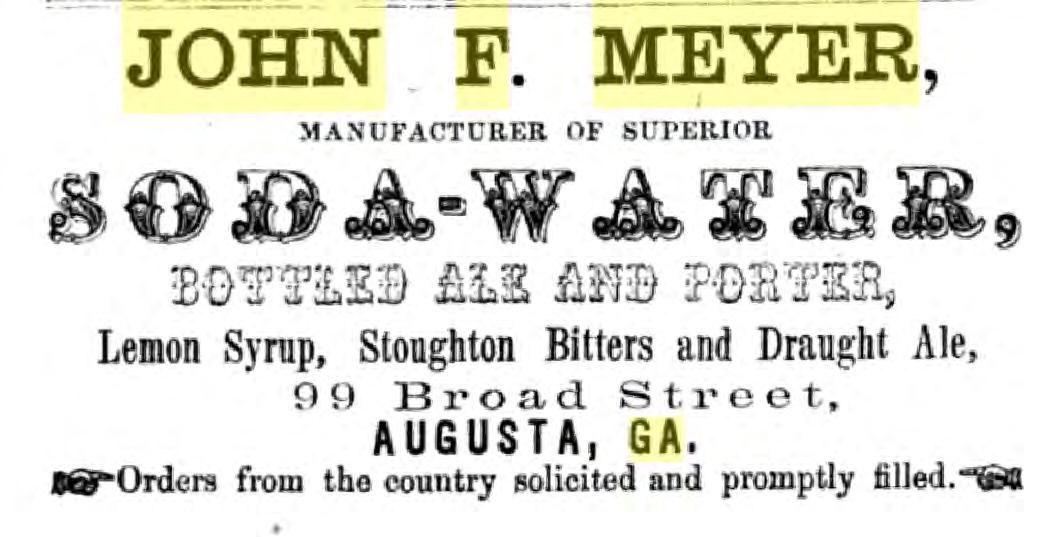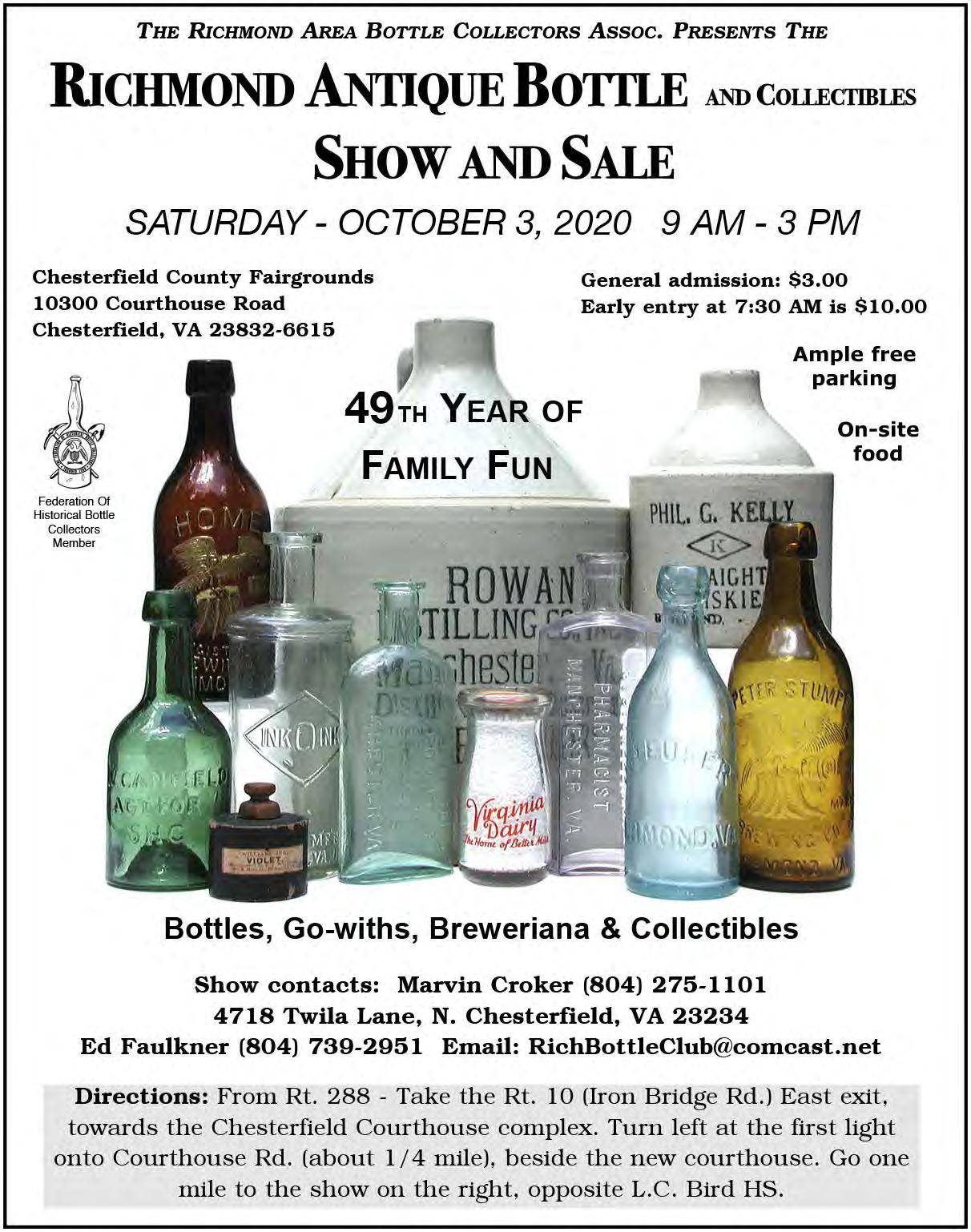
8 minute read
Killer Bottles - Several Georgia Sodas from Augusta, Savannah Fit the Bill by David Kyle Rakes
32 July - August 2020 Bottles and Extras Killer Bottles
Several Georgia sodas from Augusta, Savannah fit the bill
By David Kyle Rakes
Have you ever heard collectors at antique bottle shows refer to a “Killer Bottle?” The expression is commonly used by participants in our hobby and by definition has a number of meanings: One of a kind, super rare, attic-mint condition, superb coloration, or all of the above. And you can expect to pay a premium price for such an example.
However, the term took on another more literal meaning during my research into the backgrounds of pioneer Georgia soda manufacturers E.D. Meyer and John F. Meyer of Augusta. I sought to learn whether the two were related and stumbled across another Meyer – August W. Meyer, a Savannah, Georgia bottler, who had something else in common with E.D. Meyer besides their products: Both were tragically killed. Here is an early newspaper ad for E. D. Meyer advertising Soda Water Historical records reveal Ehlers Dietrich Meyer was born in Hanover, Germany in 1825, He was of fair complexion, had blue eyes and blond hair and stood 5-feet, 3-1/2 inches tall. He would have been in his late teens or early 20s when he emigrated to Augusta in the late 1840s or early 1850s. The records show that he became a naturalized American citizen in the city’s Court of Common Pleas on Dec. 8, 1853. He may have become the city’s first soda water manufacturer and bottler when he placed an advertisement in the Daily Chronicle and Sentinel in 1851. Readers learned Meyer was “manufacturing the best article of SODA WATER” and could “deliver it daily and in any quantity and in any part of the city.” He operated his soda water business throughout the 1850s, packaging his beverages in cobalt blue blobtopped bottles with graphite (iron) pontiled bases. They were embossed E.D. MEYER / AUGUSTA, GA. In large block lettering. There may be less than two dozen in existence.
For an unknown reason, he left Augusta in the late 1850s or early 1860s, settling in the city of Savannah 130 miles to the south. Census records list his occupation in the port city as “Bar Room Keeper,” but did not pursue the soda water business since no Savannah bottles bearing his name are known. The census also revealed he was married to Hanover native Katrina and they had a son, Augustus. A daughter was born later, probably in Savannah.
On Aug. 26, 1861, Meyer enlisted as a corporal in the German Volunteers of the Confederate Army after the outbreak of the Civil War. He served in the 1st Georgia Infantry Regiment until he was captured by northern forces at nearby Fort Pulaski in 1862. He was held as a prisoner of war until his release during an exchange of prisoners in July. He was captured a second time in June of 1864 at the Battle of Kennesaw Mountain near
Golgotha, Georgia. He was sent to the Union’s Rock Island Prison on the Mississippi River between Davenport, Iowa and Rock
Island, Illinois. It was one of the largest

and most notorious of Union prisons, with food severely rationed, leading to malnutrition and death among its inmates. But Meyer survived and took the oath of allegiance to the United States on January 26, 1865. He was released about three months before the end of the war.
He returned to Savannah and may have started a grocery business adjacent to his liquor store at the corner of East Brandy and Jackson streets. The business prospered, but Meyer soon found himself in a lot of trouble. He became a drunkard and an adulterer and physically abused his wife, according to accounts in the Savannah Morning News.
On May 28, 1873, the Meyers’ son, August, returned home to find his drunken father inside the grocery beating his mother. The young man grabbed his rifle and shot his father to death. Newspaper accounts revealed Catrina had discovered her husband having sex with a neighboring woman inside an outhouse and the discovery resulted in her being severely beaten by her husband.
August was arrested and indicted for murder, but the jury ruled the homicide was justified and found him innocent. August took over operation of the store and the 1870 census shows the son, his mother and sister Catherine living in Savannah. But August later moved to Atlanta where he was employed by the George W. Woodside Realty Company.
Exit this August and another enters.
During the early 1880s, August W. Meyer emigrated to Savannah from Germany and started a soda water business at Duffy and West Broad streets. Only two bottles from this firm are extant: ginger ales in aquamarine and teal green embossed A.W. Meyer / 1885 / Savannah, Ga., and a super rare aqua soda embossed A.W. Meyer / Savannah, Ga., in a tombstone-shaped slug plate. Not much about his personal life is known, but his business burned in 1891 and was quickly rebuilt.
Here is a pair of soda bottles from A.W. Meyer, Savannah, Ga.


KIller colors for soda water bottles from the John E Meyer Sada Water Co. (Photos Coutesy of Mike Newman)


Tragically on January 24, 1892, the 32-year-old Meyer was attacked and murdered by robbers who broke his skull and cut his throat, leaving him “lying in a pool of blood in his soda water factory,” according to a newspaper story. It was reported the robbers stole his money, a watch, diamond ring and diamond scarf pin. One of his murderers was a Negro, Gus Williams, who while awaiting his fate in jail reportedly sold his head to phrenologist Benjamin Cole for $15. Another of those charged was Joe Blois, reportedly a former employee of Meyer. Williams was hanged on July 22, 1892.
Exit another August, enter John Frederick Meyer.
He was born in 1833 in Hanover, Germany, emigrating to New York City in 1849. He and his brother, Herman, were living together, according to the city census of 1850. Herman was listed as a grocer and John a clerk. My research led me to Trow’s New York City Directory which listed John and a partner named Rottman operating a soda water business at 94 Thompson Street in 1856. John was 23 years old. Only one aquamarine bottle is known and the iron-pontiled example is embossed Meyer & Rottman / New York.
Four years later, for unknown reasons John had moved to Augusta. Surely it is just a coincidence that he and E.D. were both Hanover natives and that E.D. had moved to Savannah, opening a business door for John. It’s one of those stories that likely will never be known.
John’s smooth-based bottles were produced in many colors including forest green, teal green, yellow-green and clear glass. They were embossed JOHN F. MEYER / AUGUSTA, GA. His business was located at 99 Centre Street, now called Fifth Street, located a short distance from the city’s main street called Broad Street. He later moved to 36 Centre just
His products included bottled ale, porter, lemon syrup and Stoughton Bitters, with cream ale and champagne cider among new products sold at the later address. Perhaps his brother Herman had need of his brother because John moved back to NYC to become a partner in the soda water business from 1869 to 1876. Only two bottles are known – a squat or pony in aqua embossed H & J.F. MEYER / NEW YORK and an aqua ginger ale embossed H. & J.F. Meyer / BELFAST GINGER ALE / 139 S. 5th AVE. / N.Y. The firm moved once, winding up at 139 South Fifth Ave.
John appears to have worked for himself in the soda and mineral water business from 1880 onward. The final record of his business was listed in the 1891 Manhattan City Directory as 528 Washington Street, Manhattan. The property consisted of 11 acres and was known to be in Spring Valley, Rockland County, New York.
After his move from Augusta, John and his wife Wilhelmina became the parents of seven children: William and Ellen, born in Augusta; Mary George, Louisa, Matilda and Minnie in New York.
On July 12, 1896, John F. Meyer died at home. He was buried n the Lutheran cemetery in NYC. Executive of his estate was his son, Dr. George Meyer, and his will identified his middle initial as standing for Frederick, the only known record to reveal that information.
I was not able to learn if E.D. and John F. were related, but I was rewarded with many other facts in their life histories. Every “body” (in this case, “bottle”) has a story to tell and for me, the Meyers’ containers will always be remembered as “KILLER BOTTLES.”
SOURCES:
E.D. Meyer and John F. Meyer, Bottling Up History: Long before Coca Cola, what did Augustans drink? Bill Baab’s story in The Augusta Chronicle, June 3, 2019.
E.D. Meyer, Daily Constitutionalist, 1846-51, advertisement, April 29, 1851, Image 3; Daily Chronicle & Sentinel, Augusta, 1837-1876, August 2, 1857, Image 1, Georgia Newspapers Digital Library.
E.D. Meyer, 1860 City of Savannah Census, Chatham County, Ga., 4th District, Page 349; 1870 Census, Same.
E.D. Meyer, Compiled Service Records if Confederate Soldiers who Served in the Organizations from the State of Georgia, Roll 139, First (Olmstead’s) Infantry, National Archives Microfilm Publications.
E.D. Meyer, 1869 Registry List to Vote, Savannah Morning News 1868-1887, Feb. 3, 1869, Image 2.
E.D. Meyer Obituary, Boy Kills Father in Savannah, Daily Columbus Enquirer, 1858-73, May 10, 1873, Image 1, Digital Library Georgia Newspapers.
August W. Meyer, Savannah Sodas – An Illustrated List by Russ Butler, Havana, Fla., Page 16, 1998.
August W. Meyer Obituary in Savannah Morning News, Jan,. 25, 1892, Page 9.
John F. Meyer, 1860 Georgia Census, 1880 New York Census and 1890 Police Cen sus, NYC, Election District 10, Assembly 9, M248.
John F. Meyer, soda ads, Daily Chronicle & Sentinel, Augusta, 1837-1876, Dec. 24, 1859, Image 2, Digital Library George Newspapers.
John F. Meyer, State of New York, certificate and record of death.
John F. Meyer, Manhattan probated will, Sept. 18, 1896, Liber 553, Page 394.









